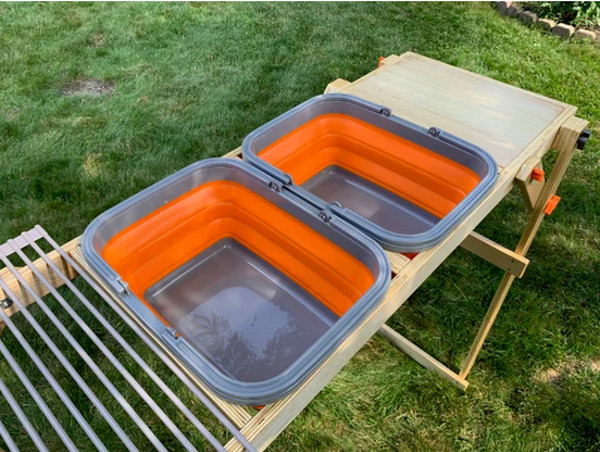Are you planning a camping trip and wondering how to keep your dishes and utensils clean? Look no further! We’ll guide you through the process of cleaning your camping dishes and utensils in the most efficient and eco-friendly way.
We’ll provide tips on washing dishes in the backcountry, the cleaning process for backcountry dishes, considerations for using soap, and the equipment needed for a camping dishwashing station.
Follow these guidelines to maintain cleanliness and hygiene during your outdoor adventures without harming the environment.
Preparing for Dishwashing
How can you effectively get ready for dishwashing while camping? When serving others in the great outdoors, it’s essential to be prepared.
Prior to starting the dishwashing process, make sure to scrape any leftover food into a packed-out trash bag. Then, gather the necessary equipment for your camping dishwashing area, including collapsible sinks or plastic bins, a pan scraper, a sponge or brush, biodegradable soap, a fine-mesh strainer, and clean dish towels or a drying rack.
Once your supplies are ready, it’s time to wash the dishes. Remove as much food as possible before washing, then use warm-to-hot water and biodegradable soap to clean the dishes. Rinse them with hot water and either air dry or use a clean dishcloth to hand-dry them.
Equipment Needed for a Camping Dishwashing Station
To establish a camping dishwashing station, you’ll require a few essential pieces of equipment.
- Think about using collapsible camping sinks, plastic bins, or buckets as your sinks. These options are portable and easy to clean.
- Ensure you have a pan scraper on hand to remove any food residue from plates, pots, and pans. A sponge or brush will be necessary for cleaning the dishes. Opt for a biodegradable soap to be environmentally friendly.
- Additionally, a fine-mesh strainer will help eliminate any solid food waste from the dirty dishwater.
- Remember to bring clean dish towels or a drying rack for drying the dishes.
With these items, you’ll be well-prepared to maintain the cleanliness and readiness of your camping dishes.

Washing and Rinsing Dishes – Step by Step Guide
Begin by scraping off any remaining food from your dishes and utensils. This will simplify the washing process and guarantee clean dishes.
After scraping, follow these steps to wash and rinse your camping dishes:
- Start by using warm-to-hot water and biodegradable soap to wash your dishes. Thoroughly scrub them with a sponge or brush to eliminate grease or dirt.
- Rinse your dishes with hot water to eliminate any soap residue. Ensure thorough rinsing to prevent any lingering soap taste.
- Optional: If you desire further sanitization, you can use boiling hot water or a sanitizing agent for enhanced cleanliness.
- Remember to dry your dishes either by air drying or using a clean dish cloth.
Optional Sanitizing Step
To ensure maximum cleanliness, it’s worth incorporating an additional sanitizing step into your camping dishwashing routine.
While washing and rinsing your dishes effectively remove food residue, adding a sanitizing step provides an extra level of cleanliness, especially when serving others.
Once you have finished washing and rinsing your dishes, you can opt to sanitize them by using boiling hot water or a sanitizing agent. Simply pour the hot water over your dishes or immerse them in a sanitizing solution for a few minutes.
This step helps eliminate any remaining bacteria or germs, ensuring that your dishes are safe to use.
While it isn’t mandatory, the optional sanitizing step can bring peace of mind and help maintain a high standard of hygiene while camping.
Drying and Storing Clean Dishes and Utensils
Once you have finished sanitizing your dishes, it’s time to dry and store them for future use. Here are three important steps to follow:
- Air drying: After washing your dishes, allow them to dry naturally before storing them. This will help prevent any moisture from causing mold or mildew to form.
- Use a clean dish towel: If you prefer to hand-dry your dishes, use a clean dish towel to ensure they’re completely dry. Make sure to use a separate towel for each type of dish to avoid cross-contamination.
- Store in a clean, dry place: Once your dishes are dry, store them in a clean and dry container or cupboard. This will help keep them free from dust, dirt, and pests.
Importance of Minimum Impact Dishwashing
To reduce your environmental footprint while washing dishes in the backcountry, it’s essential to practice techniques that minimize impact. By doing so, you can contribute to the preservation of nature’s beauty for future generations.
When washing dishes, remember to scrape any leftover food into packed-out trash and use a small spatula or camp towel for cleaning. Heat filtered water over a stove and carry the dishes and water at least 200 feet away from water sources.
Clean the dishes with hot water and a scrub pad, collecting the wash water (gray water) in a single pot. Strain the gray water using mesh or a bandana and dispose of food residue in packed-out trash.
Dispose of the gray water by either digging a sump hole or spreading it in multiple directions.
Conclusion
So there you have it, a simple and effective way to clean your camping dishes and any kind of utensils while minimizing your impact on the environment. By following these steps and using the right equipment, you can maintain cleanliness and hygiene on your camping trips.
Remember to properly dispose of your greywater to leave no trace in the wilderness.
With these tips, you can enjoy your outdoor adventures with peace of mind knowing you’re taking care of your dishes and the environment.
